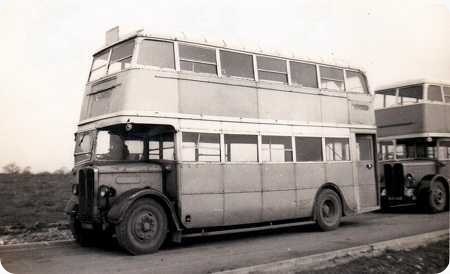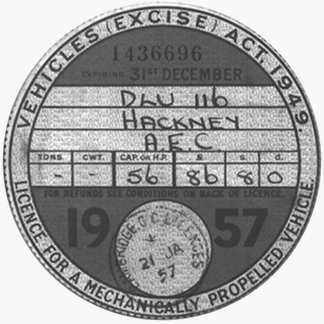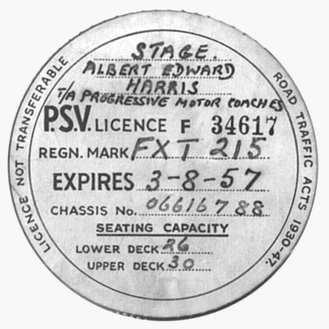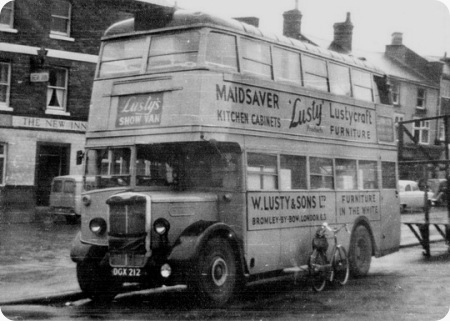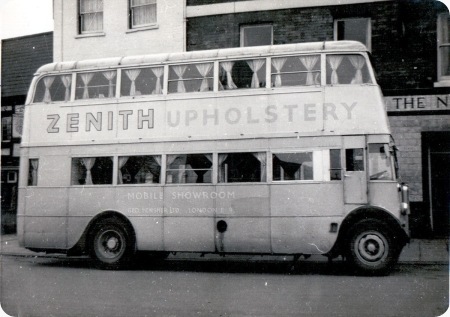
Copyright Victor Brumby
London Transport
1935
AEC Regent 1
London Transport (Chiswick) H56R
Below is the note I wrote on the back of the above photograph.
BXD 474, this yellow and blue STL (806) was seen in Kettering on March 10th. 1958. Driver Robert Carter advised that his company, Zenith Furniture, had this mobile showroom-converted AEC and two more ex-London STLs converted to pantechnicons.
I still have the 1954-7 tax discs for this bus…..
I also saw a few pantechnicons, running for Albro Furniture, during this period, all ex-STLs.
Photograph and Copy contributed by Victor Brumby
14/12/11 – 18:05
Surplus STL’s certainly got around in their twilight years. Yellow and blue sounds more like ‘happy playbus’ colours for children! Like the cab door.
Chris Hebbron
16/12/11 – 13:03
What exactly went on around that first bay? Looks like a bit of "scrapheap" coachbuilding… was there another access to the cab from the saloon? You may get in that way, but you’ll never get out!
Joe
16/12/11 – 13:19
Strangely enough, I think (minus the door) that WAS the size of the cab entrance. As for the scrapheap coachbuilding, that may also be perilously close to the truth. These bodies, or at least some of them, were prone to terminal collapse – body "sag" – in common with many of those built by NCB. The first bay may have been due to repair of such "sagging" bulkhead damage.
David Oldfield
17/12/11 – 07:30
Mention of the improvised cab door brings me to a question. The Metropolitan Police over the years imposed a lot of restrictions on LT and it’s predecessors. As examples I quote their refusal to accept, pneumatic tyres, enclosed staircases, cab windscreens and cab doors then in the RT era 8 feet wide buses in general service. I am not aware of any other British Police Force in any other provincial town or city interfering so much in bus design. Does anyone know why the Met had such extensive powers when this sort of interference didn’t seem to apply to other forces?
Philip Halstead
Good question Philip
17/12/11 – 07:34
Although what I’m saying may be well-known to some, it will not be to all. The Metropolitan Police had a very conservative approach to vehicle design and one aspect of that was not allowing cab doors to be fitted. Hence when in use as a showroom it would need to be a little more secure and I suspect that was why it the door looks so out of place and is obviously home-made.
David Beilby
17/12/11 – 07:38
I’m fascinated with the date of this picture. Monday, March 10th, 1958 was the day that my mother and I flew from London Airport to Montreal, as we were emigrating to Canada. We stayed with some distant relatives in Tooting before flying out, and I spent a large part of that last day watching LT trolleybuses whizz back and forth on the 630, whilst Victor Brumby was apparently chasing this old STL around Kettering with his camera. Trust me, there was a lot more snow on the ground in Montreal than there was in Kettering that day!
Dave Careless
19/12/11 – 06:24
Other aspects of the "progressive thinking" of the Metropolitan Police were the initial refusal to accept four wheel brakes and passenger entrance doors.
Roger Cox
19/12/11 – 11:03
London Transport, when lending its ‘Godstone’ STL’s to Merton Garage to assist the red 127 lowbridge route buses, had to ensure that its sliding doors were left open all the time, even draughtier than the standard front-entrance ‘green’ STL’s which did, to some extent, cater for not having any doors at all. Philip does raise a good question and I must admit I’ve never heard of such a ‘controlling’ police force as the ‘Met’ anywhere else in the UK. After the initial batch, not more fully front-entrance ‘red’ Q’s were built, as it was considered dangerous as passengers boarding/alighting might fall under the front wheels. I always smiled at early rear-entrance single-deckers, which had offside longitudinal seats right to the back and could have projected unwary passengers out of the rear platform when cornering hard! No mention of this was made, but they were mainly converted to front entrance later.
Chris Hebbron
31/12/13 – 07:09
It’s interesting to see that this STL has a Brighton registration BXD
Bix Curtis
31/12/13 – 12:02
Sorry, Bix, but "BXD" is not a Brighton registration, at least not in the era when this bus was first registered. BXD was definitely a London registration of c.1934/35. In that era, Brighton were using CD and UF as their main letters, with the appropriate sequential prefix. ACD and AUF appeared in 1934, and the progress letters were issued at a quite similar pace to London’s before the war – although of course London had many letter sets allocated to them, compared to Brighton’s two! (What I mean is that London buses were receiving say, FXT registrations in 1938/39, and Brighton had FUF. In wartime, many utilities in London had "G" prefix to the various letters used, and Southdown’s Guy utilities had GCD and GUF plates).
Michael Hampton
01/01/14 – 09:19
Going back to the comments of 2011 on the Met Police, the City of Manchester Police Force was equally as interfering and restrictive, though with far less influence on design than on operation. The operation of buses along Market St Manchester was always a problem and, in their own right prior to the institution of Traffic Commissioners and then, once that august group had been set up in the North West, by using considerable influence on them, the constabulary vastly influenced the pattern of service and the vehicle types used for over half a century. Henry Mattinson’s excellent long distance express bus scheme being at first truncated then almost totally demolished – with a great deal of aiding and abetting from taxi operators and the railway companies, was the first major interference, though there had been minor ones for over a decade before. The inconvenient siting of the long distance service terminal at Lower Mosley St and the restriction of North Western’s medium distance services to this outpost far from shops and offices was down to the police.
Other inconvenient termini were located at Stevenson’s Square and the rather enigmatic Royal Exchange which, apart from the airport coach stop, was not at the Royal Exchange at all. Until the appearance of the Atlantean, the only 30 foot long double deckers approaching the city centre were Mayne’s AECs which were kept away from the centre getting no nearer than Newton St., and the Crossley Dominion trolleybuses which reached Piccadilly but only on rush hour and Saturday service. Bus stop siting in the city centre, again under police influence, precluded use of forward entrance vehicles until Salford’s 27 ft PD2s appeared on the 95/96 and later the 57/77 in the early 1960s.
The Atlanteans were restricted to services away from Market St for years and whilst the major reason for not ordering more and keeping the Fleetlines that followed to Wythenshawe routes was down mainly to conservatism at 55 Piccadilly and the need for crowd movers for Wythenshawe, there is strong evidence that the police made it plain for some years that 30ft rear engined vehicles were not welcome on Market St thus restricting the best use of the vehicles. Like the Met the constabulary eventually had to yield to the pressures and realities of the industry and the time.
Phil Blinkhorn
01/01/14 – 10:05
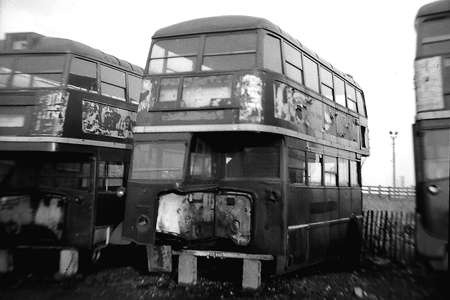
Mention was made earlier of some STLs being rebodied as pantechnicons. Several of these had their STL bodies removed by Southend Corporation Transport at their depot. A photo exists of one with the body in process of removal. The old bodies went to a Corporation dump at Shoebury, where withdrawn trolleybuses were also sent. Above is a shot of a couple of the discarded bodies.
Brian Pask
01/01/14 – 10:12
Is there any evidence, Phil, that the police in Manchester influenced the design of buses, as I earlier indicated that the Met certainly did?
Chris Hebbron
01/01/14 – 11:12
Hi Chris, Happy New Year. There is no evidence that the design of buses in terms of use or not of doors, tyres etc. for use in Manchester was directly influenced, or should we say interfered with, by the City of Manchester Police in the same way as the Met.
On the other hand, as I have shown, the types of vehicles used in parts of the city centre and restrictions on operations had a very direct influence on the size and types of vehicles purchased not just by MCTD but on a number of operators in the areas surrounding the city and certainly the location of termini had a profound influence on the daily lives of shoppers and workers.
Phil Blinkhorn
01/01/14 – 12:37
I agree that initially as a student anxious to return home to Sheffield, and latterly as a Sale resident wanting to go almost anywhere, LMS was very inconvenient – and Chorton Street not a great deal better. Looking back with a historical perspective it makes some sense – but none as a passenger. [There were similarly strange termini in Sheffield with the small Bridge Street Bus Station and the Castlegate stands – which may have made operational sense but were not in the least bit helpful to passengers needing to cross the city centre to get there.]
David Oldfield
03/01/14 – 08:13
I can’t help thinking that one of the effects of the remoteness of bus termini is to reduce awareness of what services are available. MCTD did very well in including all North Western’s Manchester services in its timetable, but how many people bought timetables? My childhood experience was that most of my parents’ awareness of bus services outside our immediate locality came under the heading of "word gets about". If people see buses showing certain destinations then they may enquire about them, but if they don’t, it may never occur to them that such a service exists.
Chorlton Street was built as an overflow to Piccadilly, and for many years MCTD restricted it to the least-used services in order to inconvenience the minimum number of passengers. But of course that also reinforced its obscurity, meaning that most Mancunian bus users had never even heard of it.
Then there was the problem of Salford. Most services heading west from Manchester didn’t go from Manchester at all, but from Salford.
How many people knew about that, I wonder?
Peter Williamson
03/01/14 – 12:13
Peter, the Salford situation is interesting. Under Henry Mattinson’s Express Service scheme, Salford buses ran through the Manchester city centre to Stalybridge, Hyde, Guide Bridge and Stockport. Once the scheme was decimated, and with Deansgate being added to Market St as another thoroughfare of "concern" to the constabulary, most of those routes Salford served retreated to that city’s side of the Irwell to join the remainder of the services showing Manchester on their blinds. Due to an earlier tramway dispute Salford buses did not cross Deansgate on anything other than those on the scheme. Victoria became the major terminus (though the bus station was nearer Exchange station) and was shown on blinds for services wholly within Salford, Manchester being shown on services from elsewhere. King St West was also a terminus, handy for those shopping at Kendal Milnes but not much good for most passengers need ing to get into the city centre and the patrons of the Docks service which terminated there would hardly have been KM’s customers until well into the second half of the 20th century. (For non Mancunians, Kendal Milnes was the Manchester equivalent of Harrods and for many years had the same owners).
The exceptions by the outbreak of World War 2 were the 15 from Worsley which ran through to Guide Bridge and the 35 from Bury, both of which were truncations of express services, the 35 logically should have run through to Piccadilly but was cut off at Cannon St. After the war there was a dispute about the termination of tram services where Salford used Manchester rails on Deansgate which exacerbated the much earlier dispute about the use of rails on Blackfriars Bridge and led to a great deal of bitterness between 55 Piccadilly and Frederick Rd. The 15 was cut back to run only from Worsley to Manchester but did reach Piccadilly and, until the new bus station was finished, terminated in view of Albert Neal’s office. Salford made sure its vehicles on the route were the most up to date and, when it needed no new vehicles for almost a decade, always turned out its smartest Daimlers to sit within Albert’s view. It was one of the first routes for Salford’s Atlanteans but by that time the terminus was within the new bus station.
Some peace was restored in January 1951 when Salford’s services from Swinton and Pendlebury were joined to Manchester’s services from Reddish Thornley Park and Bulls Head to form the 57/77 services. This became possible as no trams now ran on Market St and congestion had eased. The experiment was a success and was followed in November 1955 by the joining of the East Didsbury to Piccadilly service to the Whitefield to Victoria service to form the 95/96 services. With a common terminus at either end, these routes differed in both Salford and South Manchester but shared the same route through the city centre.
What is odd in all of this is that many long distance coaches both privately and group owned operating from outside the area to Blackpool, Southport and Morecambe ran along Market St., which formed part of the A6, without any intervention by the authorities and on summer Saturdays added to the chaos. for road users and pedestrians alike.
Phil Blinkhorn
06/06/16 – 06:45
Reference the police "interference" in London, what seems to be forgotten in the ensuing years is that the Police were also "the Commissioners for the Metropolis" thereby giving them direct control which the other cities did not have. this is why we were instantly harangued by constables for inventing short cuts on service! the famous one was forgetting to turn right at Marks and Spencer (?) at Marylebone Road on the "Z"!
Next one! has anyone remembered "The Excursion Route" insisted on by North western Traffic Commissioners which involved a lengthy circumnavigation of Central Manchester?
Pete Bradshaw
06/06/16 – 10:53
Presumably the Excursion Route was meant to avoid coaches from particularly the East Midlands and Staffordshire en route to Blackpool clogging Market St on summer Saturdays. My recollection is that in the 1960s it was regularly ignored.
Phil Blinkhorn
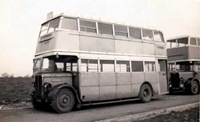 Vehicle reminder shot for this posting
Vehicle reminder shot for this posting